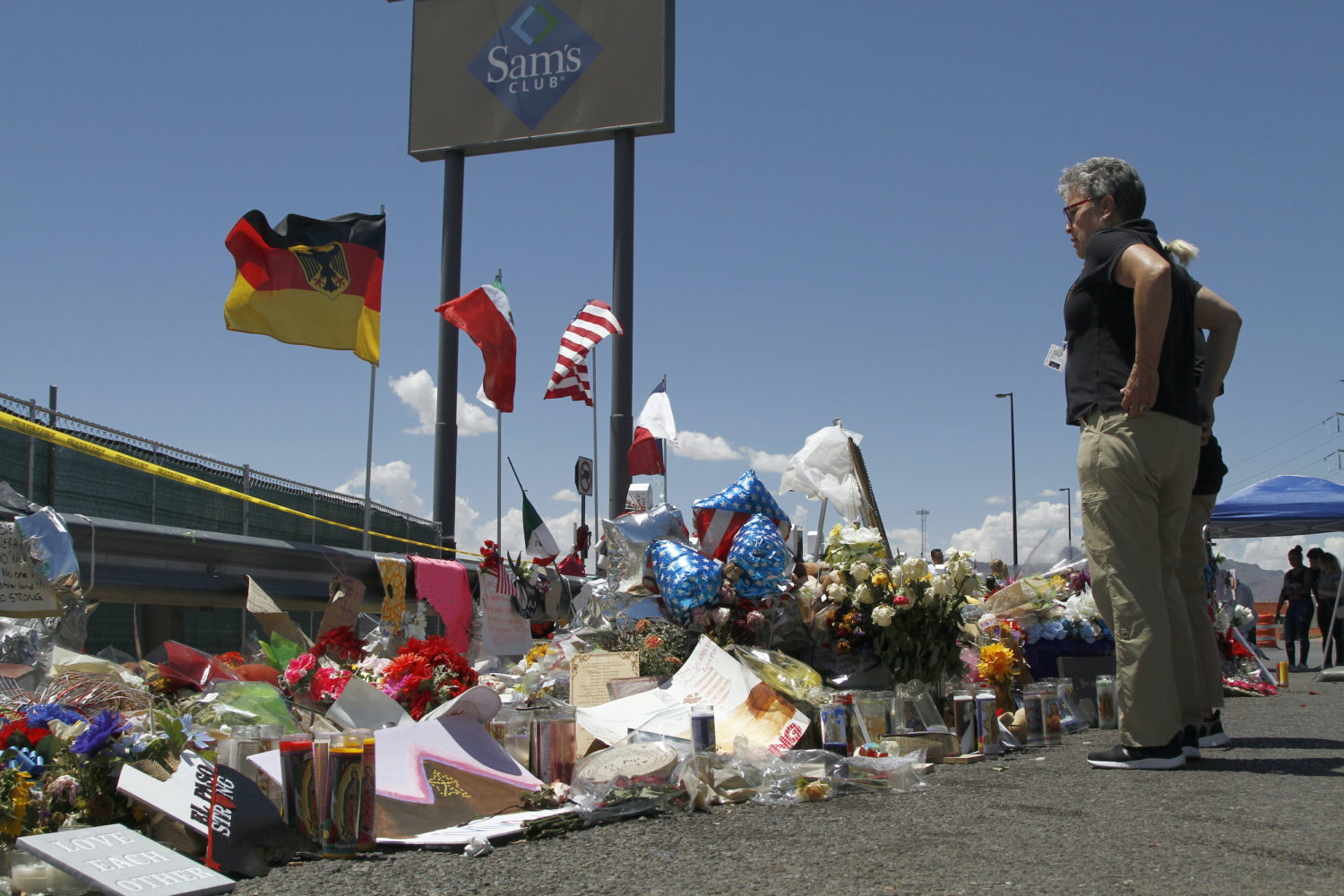 Covering COVID-19 is a daily Poynter briefing of story ideas about the coronavirus and other timely topics for journalists, written by senior faculty Al Tompkins. Sign up here to have it delivered to your inbox every weekday morning.
Covering COVID-19 is a daily Poynter briefing of story ideas about the coronavirus and other timely topics for journalists, written by senior faculty Al Tompkins. Sign up here to have it delivered to your inbox every weekday morning.
Politico said it has seen three versions of a pending Department of Homeland Security document that will label white supremacists as the No. 1 security threat to the U.S. Rated much higher than the immediate threat from foreign threats, the homegrown hate is more dangerous.
These groups use COVID-19 as just one of the issues that they can tap into to spread fear. Politico quoted from the draft versions of the Homeland Security documents:
“Violent extremists almost certainly will continue their efforts to exploit public fears associated with COVID-19 and social grievances driving lawful protests to incite violence, intimidate targets, and promote their violent extremist ideologies,” the second and third drafts reviewed by POLITICO say. “Simple tactics — such as vehicle ramming, small arms, edged weapons, arson, and rudimentary improvised explosive devices — probably will be most common.”
Politico quoted from one version of the warning:
“Lone offenders and small cells of individuals motivated by a diverse array of social, ideological, and personal factors will pose the primary terrorist threat to the United States,” the earliest draft reads. “Among these groups, we assess that white supremacist extremists — who increasingly are networking with likeminded persons abroad — will pose the most persistent and lethal threat.
“We judge that ideologically-motivated lone offenders and small groups will pose the greatest terrorist threat to the Homeland through 2021, with white supremacist extremists presenting the most lethal threat,” it adds.
Politico said from the first draft to the third draft the words “white supremacists” have been diluted but not erased.
The next two drafts reportedly allude to “Domestic Violent Extremists,” or DVEs, instead of “white supremacist extremists” as “the most persistent and lethal threat,” though all three read, “Among DVEs, we judge that white supremacist extremists (WSEs) will remain the most persistent and lethal threat in the Homeland through 2021.”
Has COVID-19 contributed to a “sex recession?”
The Centers for Disease Control and Prevention’s latest data found that last year, 38% of high school students had had sex, compared to half of all teens who had sex 30 years ago. This was a trend that began before the pandemic but may have grown in a year of social distancing. As you can see in the chart below, the decline crosses all racial lines and is sharpest among Black teenagers.
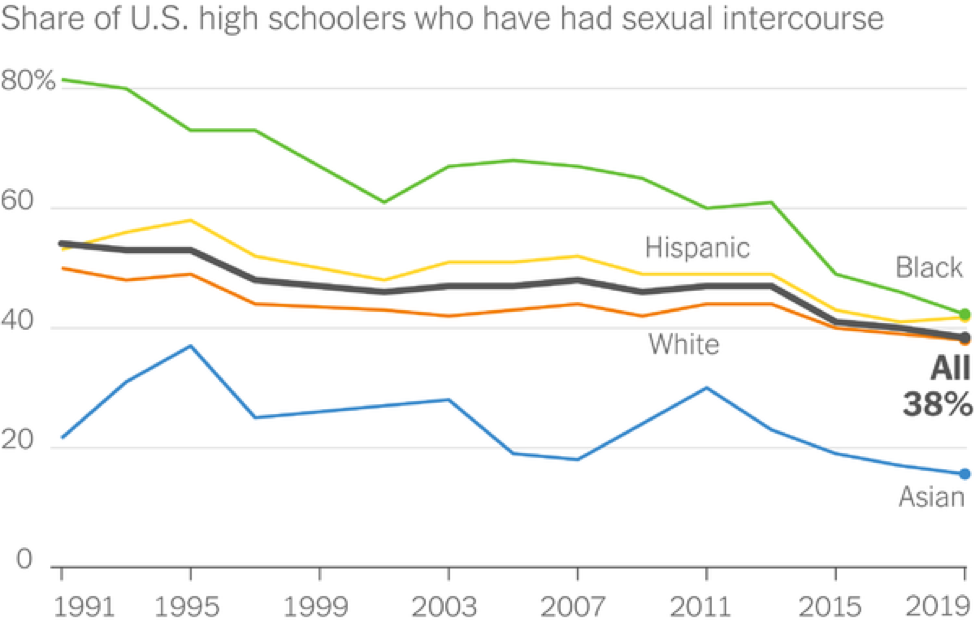
(From the Centers for Disease Control and Prevention)
The survey said 38% of females and 41% of males had sex in their high school years. Almost 9% of high school students reported having sex with four or more people in their life. 46% said they did not use a condom and more than 90% said they did not use any other kind of birth control method.
The CDC did not provide state-by-state data for every state. But when you look at the state data they do provide, it is interesting that the numbers are so similar. Certainly the pattern is similar. Let me grab a few states to show you what it looks like:
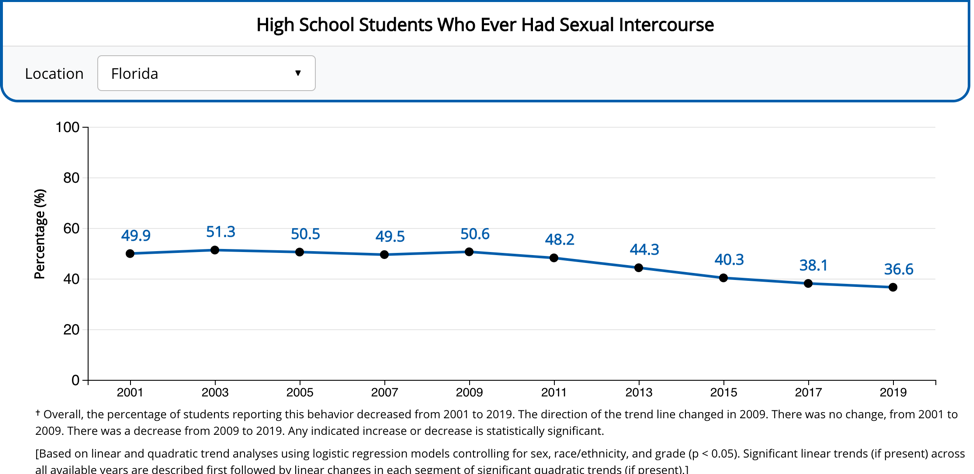
(From the Centers for Disease Control and Prevention)
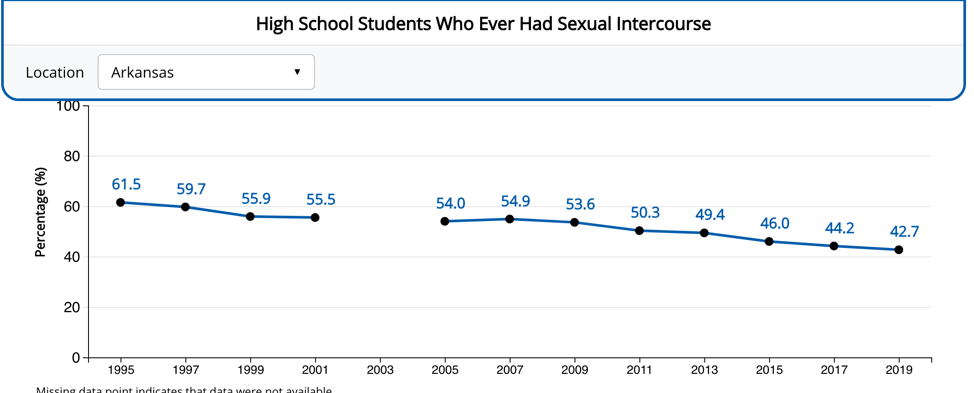
(From the Centers for Disease Control and Prevention)
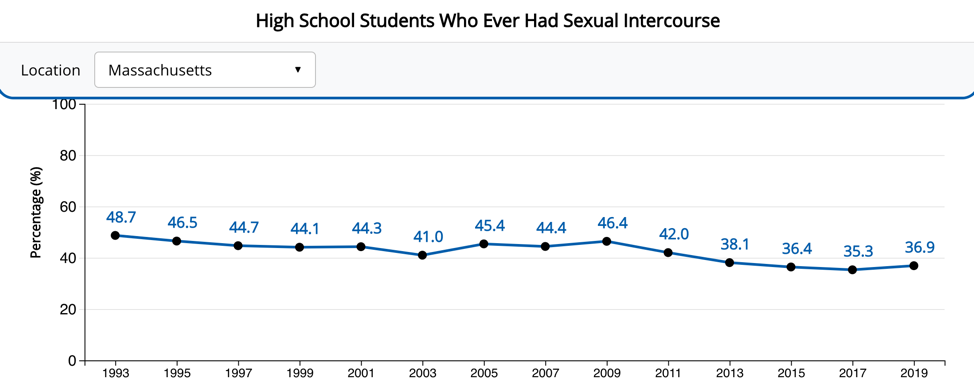
(From the Centers for Disease Control and Prevention)
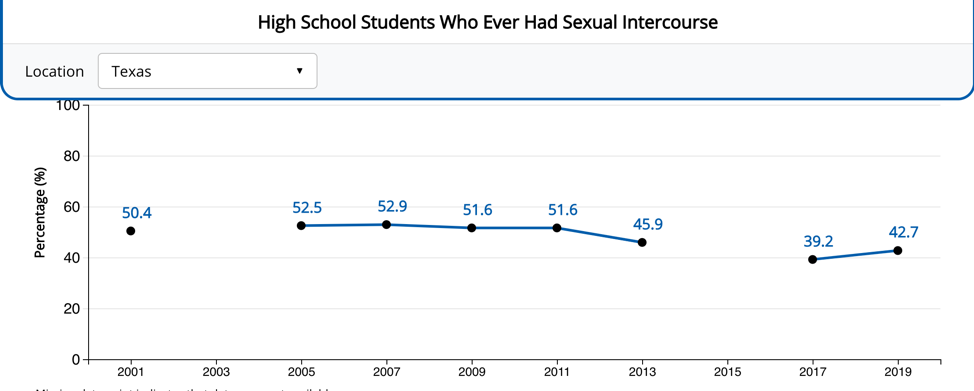
(From the Centers for Disease Control and Prevention)
In the spirit of “maybe what seems like good news is not so good,” consider this column from Kate Julian in The Atlantic that said:
To the relief of many parents, educators, and clergy members who care about the health and well-being of young people, teens are launching their sex lives later. From 1991 to 2017, the Centers for Disease Control and Prevention’s Youth Risk Behavior Survey finds, the percentage of high-school students who’d had intercourse dropped from 54 to 40%. In other words, in the space of a generation, sex has gone from something most high-school students have experienced to something most haven’t. (And no, they aren’t having oral sex instead — that rate hasn’t changed much.)
Meanwhile, the U.S. teen pregnancy rate has plummeted to a third of its modern high. When this decline started, in the 1990s, it was widely and rightly embraced. But now some observers are beginning to wonder whether an unambiguously good thing might have roots in less salubrious developments. Signs are gathering that the delay in teen sex may have been the first indication of a broader withdrawal from physical intimacy that extends well into adulthood.
Americans are socking away money during the pandemic
One of the positive trends from COVID-19, if there can be such a thing, is that we have become a nation of super-savers. That is, for the fortunate part of the population that has a job and is not overwhelmed by medical bills or overdue rent. The Atlantic reported:
The country’s “personal saving rate” — the share of people’s disposable income that gets saved or invested — has rarely exceeded 10% in the past 20 years, but it shot up to more than three times that in April. In the first few months of the coronavirus pandemic, the checking-account balances of Americans up and down the income scale rose, thanks to government aid.
The story reflects what I have seen in my own life. Since March, my family rarely spends money on restaurant food, there are of course no expenses from travel, I do not have a dry cleaning bill, I can’t recall the last dollar I spent on clothes and hair cuts are done on a must-have basis — about half as often as I used to. Movies and other outside-the-home-fun-stuff are off the calendar for now. Some people said they have been surprised by how much they are saving by not going out for lunch.
In March, when lockdowns began, spending declined steeply for low earners and high earners alike. But while low earners’ spending returned nearly to normal levels in May, higher earners’ spending has remained much lower. “The people who had the least job loss are precisely the people who have the biggest cut in spending,” Peter Ganong, an economist at the University of Chicago who co-authored a paper analyzing household finances in March, April, and May, told me.
Think about that. When people with the biggest incomes are the ones who spend less and save more, it is the people with smaller incomes who lose the most.
In mid-August, reduced spending among the top 25% of earners accounted for 57% of the estimated drop-off in spending overall, according to Opportunity Insights, a team of economic researchers based at Harvard.
The U.S. savings rate hit a record 33% in April, according to the U.S. Bureau of Economic Analysis. Since the pandemic began, BEA has been tracking how much Americans use credit cards for a number of different kinds of purchases. The only increased spending with credit cards that BEA found was on health care. Spending on clothing is getting closer to pre-pandemic levels but spending on restaurants is not near where it began earlier this year.
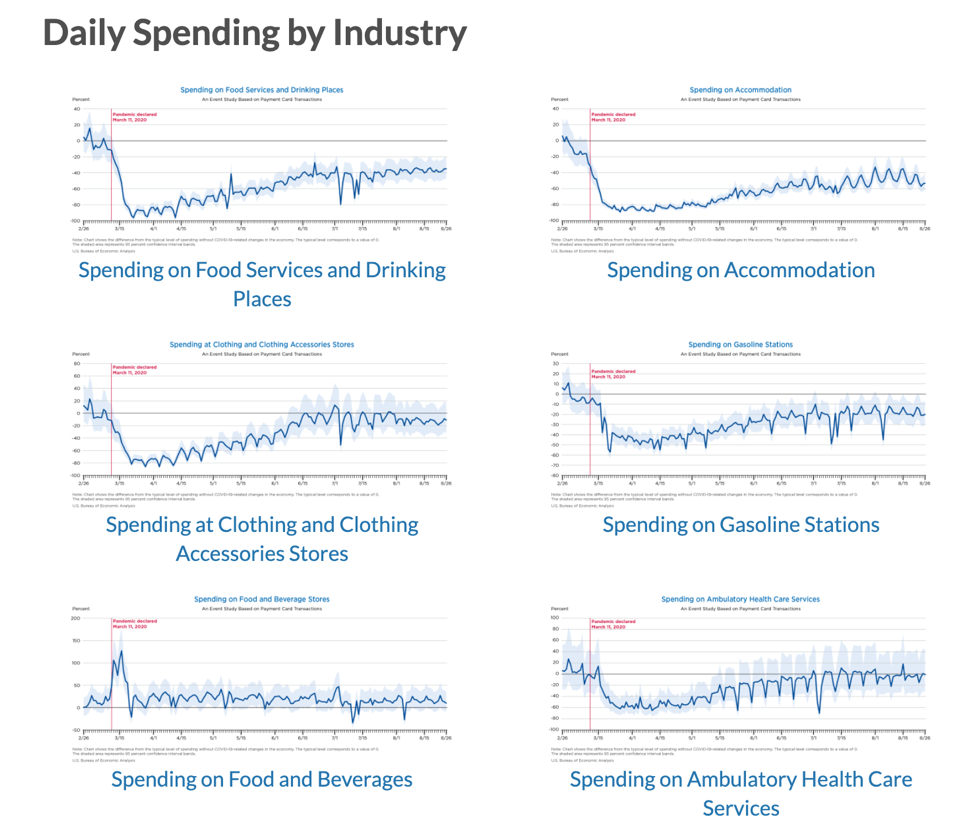
(From the U.S. Bureau of Economic Analysis)
The building day care crisis thanks to COVID-19
Axios did a nice job rounding up the pressures that are building in the day care industry.
The reporting included this quote from Alicia Modestino, an economist at Northeastern University: “The child care system needs a large-scale, immediate bailout. Full stop.”
The Center for American Progress estimated that half of day cares could be out of business soon, which would mean that once we need day care slots again, we will have lost more than 4.5 million seats. The Center said only a fourth of day cares got Paycheck Protection Program loans. And even if Congress passed a new pandemic relief bill, even the House version — which is more generous than anything the president or the Senate proposed — does not include more help for day cares.
The Center for American Progress calculated the number of day care slots that are at risk. These states have some of the highest risk of day care losses:
- Colorado: 55%
- Delaware: 58%
- Florida: 56%
- Minnesota: 55%
- Montana: 58%
- Oklahoma: 60%
- South Carolina: 63%
- Texas: 54%
Parents expect that all of this will eventually drive up the cost of child care, especially if the pandemic closes existing centers. It makes sense that child care centers might have to increase prices because tuition is based on full occupancy. But when child care centers have to operate at a reduced capacity while still having the same expenses or maybe even higher expenses, something has to give. The Pennsylvania Capital-Star found:
Day care providers told researchers in a survey that they’ve had to hire new staff, reduce class sizes, and extend their operating hours to comply with social distancing and cleaning protocols during the COVID-19 pandemic.
The new expenses have thrown an already precarious industry into a tailspin, researchers say.
“The business model for child care only works with full enrollment,” Philip Sirinides, director of Penn State Harrisburg’s Institute of State and Regional Affairs, the report’s author, said Monday on a call with reporters.
“If providers are operating below capacity, as they expect to be doing so for at least for several months, that will increase (costs),” he added.
When child care centers closed this spring, many stopped collecting tuition payments and furloughed staff. But they still had to pay rent and insurance costs.
Axios noted:
Women are suffering doubly as a result of the child care crisis, says Catherine White of the National Women’s Law Center.
- If centers close and jobs are lost, it’ll affect women, who represent 90% of the country’s child care workers. One in five of these jobs has already been lost since February.
- “And on the other side, women are taking on the burden of caregiving responsibilities at home,” says White. “They’re going to lose out most and not be able to return to the workforce if there isn’t child care available.”
We’ll be back tomorrow with a new edition of Covering COVID-19. Sign up here to get it delivered right to your inbox.
Al Tompkins is senior faculty at Poynter. He can be reached at atompkins@poynter.org or on Twitter, @atompkins.

